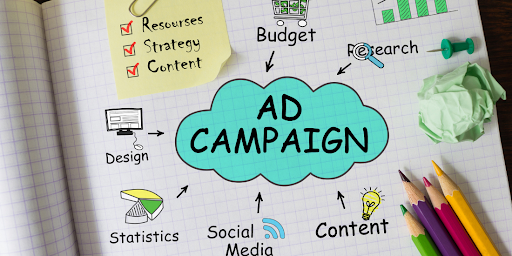The Complete Google Ads Beginner’s Guide
Google Ads; the holy grail of online marketing. It’s an unbeatable platform that can take your business to new heights…if you know how to use it correctly, that is. If not, you won’t hear the end of it from your boss. Of course, if you are your boss, you won’t hear the end of it from yourself (and your accountant).
“Why aren’t we getting any sales?!”
“What’s wrong with our website?! It needs more hits!”
“I think we should just give up on this whole online thing…”
Sound familiar? If you’re new to Google Ads or have been using it for a while but haven’t seen the results you were hoping for, don’t despair. Marketers, SMEs and entrepreneurs worldwide have been in the same boat, and they’re still sailing today. The reason? Google Ads is a complex beast, and if you want to tame it, you need to understand how it works.
But where do you start? What do you need to know? And how can you make sure you’re not wasting your hard-earned cash?

We’ve put together the ultimate Google Ads beginner’s guide developed on evergreen principles, covering everything from setting up your account to more complex topics like search campaign types and negative keywords.
The Complete Google Ads Beginner’s Guide
With decades of experience in PPC -specifically Google Ads- we’ve seen it all. We’ve jumped for joy when our clients’ campaigns take off, and we’ve been there to lend a shoulder to cry on when things haven’t gone quite as planned.
But, most importantly, we’ve learned from our successes and failures, and now, we can share that wisdom with you.
We know the ins and outs of Google Ads like the back of our hands, and we’re passionate about helping businesses succeed online. As Google Partners, we’re in a unique position to stay ahead of the curve when it comes to new features and changes on the platform. And we also know a few secrets… but we’ll keep those to ourselves, for now.
Google Ads can be a tough nut to crack, but we’re here to help you get started on the right foot. Whether your industry is B2C or B2B, or even if you’re just a one-man-band selling your products or services, you’re sure to see success if you follow Google ads best practices in this guide. It’s easy, we promise.
So, sit back, relax and let us take you on a journey through the Google Ads galaxy. By the end of it, you’ll be soaring to new heights and raking in sales.
Enter the World of Digital Marketing
The world of digital marketing is vast, and Google Ads is just one part of it. If you want to get the most out of your Google Ads campaigns, you need to understand how digital marketing works as a whole. That includes everything from SEO to social media marketing, and email marketing to lead generation.

Don’t worry; we’re not going to bombard you with too much information all at once. Instead, just think of this section as a primer to get you started on your Google Ads journey. After all, knowledge is power, and the more you know about digital marketing, the easier it will be to create successful Google Ads campaigns.
Here’s a quick overview of some of the most critical aspects of digital marketing:
- SEO: Search engine optimization (SEO) is the process of optimizing your website for Google search to get more organic, or unpaid traffic.
- Content marketing: Content marketing is about creating and sharing valuable content that attracts, engages, and converts your target audience.
- Social media marketing: Social media marketing is the process of using social media platforms like Facebook, Twitter, Instagram, and LinkedIn to build relationships with potential and current customers.
- Email marketing: Email marketing consists of sending emails to potential and current customers with the goal of building relationships and driving sales.
- PPC: Pay-per-click (PPC) advertising is a type of digital marketing where businesses can pay to have their ads shown on Google and other search engines.
For all of the above digital marketing channels, you’ll need to run campaigns. Campaigns are basically just a group of marketing activities that share the same goal.
So, for example, if your goal is to increase brand awareness, you might run a social media campaign and an email marketing campaign. If your goal is to generate leads, you might run a PPC campaign and an SEO campaign. If your goal is to increase sales, you might run a content marketing campaign and a social media campaign. And so on.
Similarly, (and this will make more sense once we get into the nitty-gritty of campaigns) your Google Ads campaigns will be made up of individual ad groups. Ad groups are just a group of ads that share the same goal. But more on that later.
For now, let’s move on to the next section, where we’ll introduce you to the wonderful world of Google Ads.
This Google Ads Beginner's guide was developed on evergreen principles, covering everything you need to know to kick off quickly.
Why Google? Why Google Ads?
Why Google? Seriously? Have you ever heard someone say, “let’s search for it on Bing” in the last… we don’t know… ten years? Didn’t think so.
Google is the undisputed leader when it comes to search engines, which is why businesses worldwide need to be on Google if they want to increase their bottom line and be visible to their target audiences.
Apart from the fact that Google welcomes 259 million unique visitors daily and 1.2 trillion searches per year worldwide, there are plenty of reasons to choose Google Ads over other advertising platforms.
Here are just a few:
- Google is the most popular search engine globally, so you’re guaranteed to reach a large audience.
- Google Ads is an effective way to reach your target audience when they’re searching for products or services like yours (and even if they aren’t).
- Your Google Ads account is flexible, so you can control your budget and choose how much you want to spend on each campaign.
- It’s measurable, so you can track your progress and see how your Google Ads search campaigns are performing.
- You pay for clicks (CPC), not impressions. In comparison to other platforms, like Facebook ads, for instance, Google Ads is more effective because you’re only paying for ads that are clicked on, not ads that are seen.
When combined, these reasons -and many more- make Google Ads a powerful tool that every business should take advantage of. If you’re not, consider this your official wake-up call.
Where Can You Publish With Google Ads?

The short answer is: on Google. The slightly longer answer is: on Google and its partner websites.
When you create a Google Ads search campaign, your ad can appear in two places:
- Google Search Network: This is a group of websites that includes Google Search, Maps, YouTube, and millions of other websites that show Google ads.
- Google Display Network: This is a group of more than 2 million websites, apps, and videos across the internet that show Google Display Ads. The Display Network reaches over 90% of global internet users, so you’re sure to reach your target audience.
Let’s take a closer look at each one.
Google Search Network
The Google Search Network is a collection of search-related websites and applications where your advertisements may be displayed. When someone performs a search using keywords connected to one of your keywords, your ad can appear near the results page.
Google Search ads may appear above or below search results on Google. They can be found on the Shopping tab, Google Images, Google Maps, and the Maps app as well. But it’s important to note that not all searches on the Google Search Network will result in your ad being shown. Your ad will only appear if it’s relevant to the user’s search.
For example, let’s say you own a pet store and someone searches for “pet supplies.” If your Google Ads search campaign targets that keyword, your ad might appear above or next to the organic search results. However, if they search for “pet food,” your ad might not arise since it’s not relevant to what they’re looking for.
It’s a relatively simple concept, but it’s important to understand because it will affect your campaign’s success. If you’re not targeting the right keywords, then your ad might not appear even if someone is searching for something relevant to your business.
If you’re stuck, an expert can help you determine the best keywords for your Google Ads search campaign.
Google Display Network
The Google Display Network shuts down the competition by giving your ad space on more than two million websites, apps, and videos across the internet. That’s a lot of real estates.
When you create a Google Display ad, it can appear in one of three places:
- On a website: Your ad will appear on websites that are part of the Google Display Network.
- In apps: Your ad will appear in apps that are part of the Google Display Network.
- On YouTube: Your ad will appear on YouTube videos that are part of the Google Display Network.
The great thing about the Display Network is that it gives you the opportunity to reach people who might not be actively searching for your product or service. But that doesn’t mean they’re not interested.
For example, let’s say you sell eco-friendly cleaning products. Your ad might appear on a website about green living or on a YouTube video about DIY cleaning hacks. Someone who sees your ad might not have been searching for “eco-friendly cleaning products,” but they’re still interested in what you’re selling.
The Display Network is a powerful tool that can help you reach your target audience, even if they’re not actively searching for your product or service.
So, What’s the Difference Between Google Search Network and Google Display Network?
Although both the Google Search Network and the Google Display Network can be effective, they’re two very different beasts.
Google display advertisements, and their paid search siblings, still originate within the Google Ads interface. However, Google search ads only appear on the Google Search Network, while Google display ads can appear across the entire GDN.
The primary distinction between Google search ads and display advertising is that search advertisements are a type of “pull” advertising, whereas display advertisements are a form of “push” advertising. This means that Google search ads are displayed to users who are actively searching for the product or service that you’re offering. On the other hand, Google display ads are shown to users even if they’re not actively searching for what you’re selling.
Google Ads Account Structure
One of the most important aspects of a successful Google Ads campaign is account structure. A well-structured account is easier to manage, optimize, and scale.
We’ll walk you through the basics of account structure so that you can create a foundation for success.
Anatomy of a Google Ads Account
Welcome to your Google Ads account. This is your home base for all of your campaigns, ad groups, ads, and keywords.
Once logged in, you’ll see a navigation panel with all of the different Google Ads tools and features to the left of your screen. This is where you’ll go to create new campaigns, ad groups, ads, and keywords.
In the center of your screen, you’ll see your account’s data. This is where you can track your campaigns’ performance, get insights into your target audience, and see how much money you’re spending.
To the right of your screen, you’ll see a toolbar with options for managing your account. This is where you can access your account settings, billing information, and support options.
Now that you know your way around the Google Ads interface, let’s talk about campaigns.
Google Ads Search Campaign

A Google Ads account is made up of campaigns. Each campaign is made up of ad groups. And each ad group is made up of ads and keywords. Campaigns must be split -it’s the only way to measure and optimize your campaigns effectively.
Let’s break it down:
- Campaigns: A campaign is a collection of ad groups that share the same settings. For example, you might have one campaign for your search ads and another campaign for your display ads.
- Ad Groups: An ad group is a collection of ads and keywords. Ad groups are where you set your budget, bid, and targeting options.
- Ads: Ads are the actual ads that you’ll create. They can be text ads, image ads, video ads, or even app ads.
- Keywords: Keywords are the words or phrases that trigger your ad to appear.
When creating a campaign, you’ll need to set a few options:
- Campaign Type: Search, Display, Video, Shopping, or App
- Campaign Subtype: Standard, All Features, or Mobile App Install
- Bidding Strategy: CPC or CPM
- Budget: Daily budget for the entire campaign
- Language and Location: Language(s) and location(s) where your ads will be shown
Keeping up? Great! Now let’s talk about ad groups in more detail.
Ad Groups: The Foundation of Your Campaign
As we mentioned before, an ad group is a collection of ads that target a shared set of keywords. Ad groups are where you set your budget, bid, and targeting options.
There are a few things to keep in mind when creating an ad group:
- Ad groups must be relevant. All of your ads and keywords should be related to the same topic.
- Ad groups must be targeted. You’ll need to choose who will see your ads. Will they be shown to people in a specific location? Or people who speak a particular language?
- Ad groups must be structured. Ad groups should be organized into smaller, more manageable chunks. For example, you might have one ad group for each type of product that you sell.
- Ad groups must be tested. You’ll need to test different ad groups to see which ones perform the best.
Ad groups to Google are like a foundation to a house. Get them right, and everything else will beautifully fall into place.
Keywords: The Words That Trigger Your Ads
In pay-per-click marketing, keywords are the creme de la creme of your ad campaigns. They’re the words and phrases that trigger your ads to appear.
To ensure your Google Ads search campaign is a huge success, you’ll need to choose the right keywords. But there are a few different ways of carrying out keyword research, and each serves a different purpose:
- Finding Negative Keywords: Negative keywords let you exclude certain words or phrases from your campaign. That way, your ad won’t show up when someone searches for those terms.
- PPC Keyword Research Tools: Several PPC keyword research tools are available online. They’ll help you find relevant keywords for your campaign. Google’s Keyword Planner tool is a fantastic place to start.
- Keyword Bidding: Regardless of business size, all companies should be aware of keyword bidding and how it works. Keyword bidding is the process of choosing how much you’re willing to pay for each click on your ad. If you have a limited budget, you’ll need to be strategic about which keywords you bid on.
- Keyword Grouping: Related keywords are organized into tight groups so you can manage them more effectively.
Google Ads: Important Terms to Know
When you start using Google Ads, there are a few terms that you need to be familiar with:
- Ad Rank: Your ad rank is a number representing how your ad will perform compared to other ads. It’s based on factors like your bid amount, the quality of your ad, and the relevancy of your keywords.
- Clicks: A click is when someone sees your ad and, well, clicks on it.
- Conversions: A conversion is when someone sees your ad and takes the desired action, such as making a purchase or signing up for your email list.
- Cost-per-Click (CPC): CPC is how much you’re paying for each click on your ad.
- Cost-per-Thousand Impressions (CPM): CPM is how much you’re paying for every thousand times your ad is shown.
- Impressions: An impression is when your ad is shown to someone, regardless of whether or not they click on it.
- Ad Extensions: Ad extensions are extra features that you can add to your ad, such as your phone number or address. They make your ad more noticeable and can help improve your click-through rate.
- Bidding Strategies: There are a number of different bidding strategies that you can use to manage your ad campaigns. From target CPA to enhanced CPC, there’s a bidding strategy to suit every business.
- Quality Score: A quality score is a number that represents how relevant and useful your ad, keyword, and landing page are to the person who sees it.
Google Ads Campaign Types
When you create a Google Ads campaign, you’ll need to choose which type of campaign you want to run. The five main types of Google Ads campaigns are:
- Search Campaigns: Text ads on the Google Search Network.
- Display Campaigns: Image-based ads on the Google Display Network.
- Video Campaigns: Ads on YouTube and other video websites.
- Shopping Campaigns: Product listing ads that appear on the Google Search Network and Shopping websites.
- Universal App Campaigns: Ads for apps that appear on the Google Search Network, Display Network, YouTube, and within other apps.
Create Your First Campaign On Google Ads

We finally get to the fun part: creating your first campaign on Google Ads!
#Step One: Create Your Google Ads Account
If you don’t already have a Google Ads account, you’ll need to create one. It’s super easy; all you have to do is head to ads.google.com and click “Start now.”
Once you’ve signed up, you should see a screen that asks you for all the information about your business, such as your website URL, time zone, and currency. Google will try to take complete control here, which is okay for some. However, you have Adcore in your corner (see what we did there?).
You don’t need Google’s robotic automation because you’ve got us, the real people. We’ll show you how to set up your account manually so that you can have more control over your campaigns and avoid any potential errors.
Trust us? Of course, you do! You can now head to the bottom of the screen and click the small link at the bottom that says “Switch to Expert Mode.” You’ve now arrived at the Google Ads interface that we know and love.
#Step Two: Select Your Campaign Goal
Expert Mode comes with its own world of options and choices. The first thing you need to do is pick your campaign type.
On this screen, you’re going to see the below options:
- Sales
- Leads
- Website Traffic
- Product
- Brand Consideration
- Brand Awareness
- Reach
- App promotion
- Or, Without Google’s Guidance
You may find that your objectives fall in line with one of Google’s options. If that’s the case, you can go ahead and select that option. However, we recommend holding on to that control, and not letting Google decide for you. Instead, click on “Without Google’s Guidance.”
#Step Three: Select Your Campaign Type
Remember the options we gave you earlier? Next, it’s time to select your campaign type!
On this screen, you’re going to see the below options:
- Search Network Only
- Display Network Only
- Search Network with Display Select
- Shopping
- Video Campaigns
- Universal App Campaigns
Choose which campaign type is best for you and your business goals. If you’re not sure, don’t worry! Just get in touch with the experts at Adcore; we can help you out.
#Step Four: Results
On this page, Google will ask you what results you would like to achieve from your Google Ads search campaign. This can be in the form of; web visits, calls, or application downloads.
Again, if you’d like to maintain control over your campaign, we recommend leaving this section blank. However, if you want Google to make decisions for you, go ahead and select an option.
#Step Five: Ad Groups and Keywords
The next step is to set up your ad groups and keywords. If you’ve survived the article up until this point, then you know a lot about ad groups and keywords already.
On the other hand, if you’ve just joined us and scrolled down, you missed a lot of very important information (and some great puns). But no worries, we’ll give you a quick recap.
- Ad Groups: A collection of ads and keywords with similar themes.
- Keywords: The words or phrases that trigger your ad to appear on the search engine results page.
First, start with your core service when picking which keywords to utilize. This will ensure that your ad is triggered when people are specifically looking for what you have to offer.
Then, add in some variations of your primary keyword by using Google’s Keyword Planner. These could be long-tail keywords, misspellings, negative keywords, or different word orders.
#Step Six: Create Your Ad and Publish!
Now it’s time to create your ad! This is the best part, where you get to be creative and come up with an enticing offer that will make people want to click on your ad.
Remember that you only have a limited amount of space, so make sure your message is clear and concise. Also, don’t forget to include a call to action! Once you’re happy with your ad, it’s time to hit that publish button and see your hard work pay off.
And there you have it! You’ve now created your first Google Ads campaign, all without Google’s help. Something to be pretty proud of if we do say so ourselves. Just remember, if you ever need a hand, the team at Adcore is always happy to help.
Your First Campaign Is Live! Now What?
Now that your campaign is live, it’s time to start thinking about Google Ads’ best practices.
The first and most important rule is to always be testing. Try different ad copy, different keywords, different match types, and different bid amounts. By constantly testing, you’ll be able to see what works best for your business and your goals.
Basic optimizations that we recommend for all campaigns are:
- Review your search terms report and add negative keywords.
- Check your ad extensions and make sure they’re relevant to your campaign goals.
- Check your Quality Score and work on improving it.
- Make sure you’re testing different ad copy and calls-to-action.
Last but not least, don’t forget about bidding strategies. As we mentioned at the start, this is what will determine how much you’re willing to spend on each click. We recommend researching the different bidding strategies and finding which one works best for you and your budget.
And that’s a wrap! You should now have a pretty good understanding of Google Ads and how it works. If you have any questions or need help getting started, feel free to reach out to us.
Adcore Elite is an international advertising agency leading with technology at our core. We love to stay ahead of the curve and are always on the lookout for new platforms, features, and strategies to add to our ever-growing, evergreen toolkit.
If you need help getting started or want to take your campaigns to the next level, we’re here for you. Click here to get in touch!
Trending Articles
Get exclusive CMO tips that I only share with email subscribers.
Related Articles


